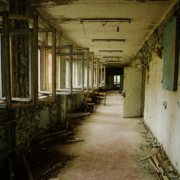BAM Construct UK has collaborated with Altro and Recofloor to achieve significant sustainability gains on a number of major school construction projects.
At Weldon Village Academy, a new purpose-built secondary school near Corby, BAM Construct UK built the state-of-the-art, three-storey facility to provide education, sport and recreation facilities for the community as well as the school population. At the start of the project, Dave Ellis, Regional Director – Midlands for BAM Construct UK said: “Sustainability will be central to our approach as we look to create a school that features eco-efficient features.”
To ensure an overarching sustainable building, the interior materials were selected for, among other criteria, their reduced embodied carbon properties. This included the flooring throughout, which needed to provide recyclability and high slip-resistance for busy areas, such as corridors and classrooms. BAM Construct UK approached Altro, their supply chain partner, for support and guidance with specifying the correct floors.
Adhesive-free safety floor Altro XpressLay was specified for the corridors and classrooms, providing speed of installation and ease of maintenance ensuring the busy areas were returned to use quickly and completed to project timescales. Altro XpressLay is installed without adhesive or DPM, providing easy access to subfloors, and avoiding any unpleasant adhesive odours.
Like all Altro adhesive-free floors, it utilises a unique formulation for a quick fit without compromising on performance or durability. The revolutionary technology, featuring a studded surface on the underside of the floor, allows it to lie flat and perform like a traditionally adhered floor without the need for an adhesive. Floors can be installed and walked on the same day.
Recofloor, the UK’s first waste vinyl floor take back scheme, was introduced into the build, providing collection of clean vinyl offcuts for recycling. “Shared objectives from the outset contributed to a successful and sustainable outcome” explains Carla Eslava, Recofloor Scheme Manager. “Every offcut matters when it comes to diverting waste vinyl from landfill.” The vinyl offcuts collected from the 3,000 sqm of Altro XpressLay installed at Weldon Village Academy avoided 1.88 tonnes of embodied carbon emissions.
Sustainability was also high on the agenda for the new school extension at Holyrood Academy, Somerset. The architect initially specified traditional adhered flooring, but main contractor BAM saw the opportunity for time and cost savings as well as huge sustainability benefits by switching the specification to adhesive-free options.
Representatives from BAM Construct UK, Altro and Recofloor met to discuss options for specification, and managing and recycling waste from the build. After the consultation, and with prior knowledge and experience of previous successful installations, adhesive-free floors options were reviewed and selected based on the cost and time benefits, plus embodied carbon avoided.
“It was imperative we delivered the build to timescales, but as sustainably as possible. The adhesive- free floors saved project time and reduced carbon output.” said Graham Holt, Construction Project Manager, BAM Construct UK.
At Holyrood Academy, Altro Wood adhesive-free safety floor was specified for the dining area and Altro Cantata adhesive-free was specified for the corridors and communal areas, providing a safe, durable and decorative solution for the busy spaces.
David Lever, Altro’s Sustainability Manager, says: “There are many cost and time advantages to using Altro adhesive-free flooring, which requires no adhesive and no damp-proof membrane, but the saving in embodied carbon achieved by avoiding these elements is the real headline grabber. Figures produced by the team on the Holyrood Academy project showed that switching the specification from adhered to adhesive-free gave an approximate carbon-saving of 59%, preventing 3.89 tonnes of embodied carbon emissions.”
There are also plenty of benefits when it comes to installing Altro adhesive-free floors, as John Redford from RBJ Flooring, the installer at Holyrood Academy, explains: “It went really smoothly, in large part due to the planning and professionalism of the main contractor and the products selected for use. The site was prepared and ready for when we arrived, and our team enjoy working with the Altro products, particularly adhesive-free, which we have a lot of experience with. Using these takes out the wet trades, means we don’t have to lump around 100s of bags of screed, mix it, clean everything down and so on. We’re very happy laying these products.”
Find out more about the many benefits of adhesive-free floors here: www.altro.com/uk/learn-and-engage/altro-guides/adhesive-free-floors










